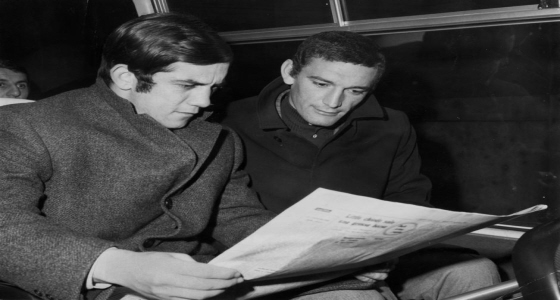
©Words - Siane Daley
The V&A Museum in London is hosting ‘The Glamour of Italian Fashion, since 1945’ exhibition. The first of its kind, the exhibition showcases the unique contribution of Italian fashion to the industry, which came to the forefront in post WWII Italy under the Italian government, designed to re-establish and improve the Italian economy.
The exhibition, curated by Sonnet Stanfill, runs from 5 April – 27 July 2014, and is sponsored by luxury-brand Bulgari. It features 120 ensembles and designs by leading Italian fashion-houses, including Dolce & Gabbana, Giorgio Armani, Fendi, Gianfranco Ferre, Gucci, Missoni, Prada, Pucci and Versace.
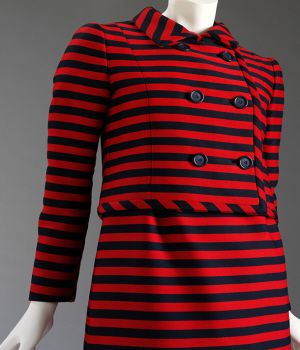 Organised into six distinct sections; ‘Sala Bianca’, ‘Men’s Tailoring’, ‘Lo Stilista’, ‘Knitwear’, ‘Accessories’ and ‘Fashion and Image’; the exhibition charts the Italian fashion-industry’s journey from 1945 to the current day.
Organised into six distinct sections; ‘Sala Bianca’, ‘Men’s Tailoring’, ‘Lo Stilista’, ‘Knitwear’, ‘Accessories’ and ‘Fashion and Image’; the exhibition charts the Italian fashion-industry’s journey from 1945 to the current day.
The ‘Sala Bianca’ refers to the first international catwalk shows held in Florence, and organised by Italian designer Giovanni Battista Giorgini. These showcased Italy’s finest designs and designers, and marked Italy as a fashion-capital to rival Paris. The standout pieces in this collection include a quilted cocktail dress by Carosa, 1958-9. This cappuccino-coloured design features an A-line silhouette, and the hand-stitched quilted pleated-design is similar to the contemporary design of the‘puffa’ jacket. Giorgini’s notebook is also on display, which shows Emilio Pucci’s signature, alongside original vintage black and white photographs, and rare archive-footage from the Sala Bianca catwalk show itself.
Also displayed is a silver sequin evening dress and matelassé coat, 1966, designed by Mila Schon, which was worn by Princess Lee Radziwill (sister of Jacqueline Kennedy), to Truman Capote’s legendary Black and White Ball. Schon was chosen above designers from Paris or London to design this ensemble for Radziwill. The silver-grey dress, features sequins on net design, with an accompanying silk coat. Schon was a Milanese couturier known for her elegant, simple yet classic designs.
The ‘Sala Bianca’ section also references the impact of influential films of the 1950’s and 60’s era, where Hollywood stars such as Audrey Hepburn and Elizabeth Taylor propelled Italian fashion and lifestyle (‘La Dolce Vita’), onto the world-stage. Numerous Hollywood films such as ‘Anthony and Cleopatra’, ‘War and Peace’ and ‘Roman Holiday’ were filmed on location in Italy. Film stars such as Elizabeth Taylor, Ava Gardner and Audrey Hepburn shopped whilst on location and became ambassadors of Italian style. Featured is the film-costume that Hepburn wore in the film ‘War and Peace’ designed by Fernanda Gattinoni.
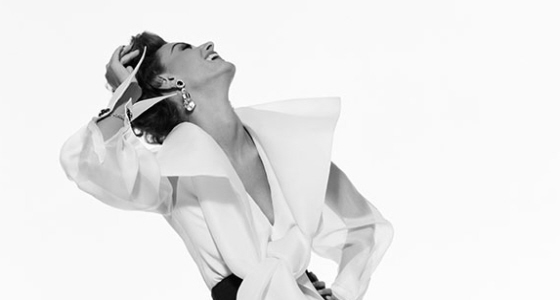
Synonymous with Italian lifestyle, and signifying a care-free spirit in post-war Italy, is the classic Vespa scooter. An original Vespa 125, in mint-green and mint-condition, is on display, which was one of the first fifty scooters imported to Britain.
In the ‘Men’s Tailoring’ section, suits by Carlo Palazzi and Ermengildo Zegna are featured. Italian tailoring gained worldwide recognition and popularity in the post-war era, due to its unique quality, whereby the tailoring is light, yet unstructured, with a sleek silhouette. Fellini’s film ‘La Dolce Vita’ also helped to popularise the Italian suit globally. On display is a suit by the family-run atelier Rubinacci, known for their skillful tailoring in particular their pocket shaped like a 'pignata'.
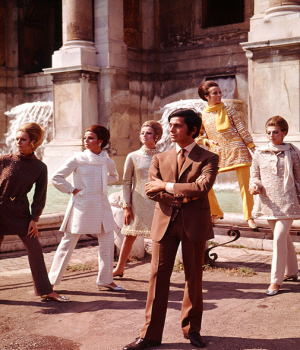 In this section, Roberto Cavalli's 1970's hand-painted leather tunic and trousers ensemble, with fringed, almost ‘Native-American' design, is prominent. Cavalli patented the design of printing onto leather and suede, and his use of these raw materials pays homage to the regional and traditional craftsmanship of Italian artisans. Similiarly, the 'Intrecciato Bag' by Bottega Veneta, 2014, references regional manufacturing in its distinctive, yet minimalist hand-woven design and its absence of a logo.
In this section, Roberto Cavalli's 1970's hand-painted leather tunic and trousers ensemble, with fringed, almost ‘Native-American' design, is prominent. Cavalli patented the design of printing onto leather and suede, and his use of these raw materials pays homage to the regional and traditional craftsmanship of Italian artisans. Similiarly, the 'Intrecciato Bag' by Bottega Veneta, 2014, references regional manufacturing in its distinctive, yet minimalist hand-woven design and its absence of a logo.The standout ensemble was the Fendi Coat from the 'Inlaid Polychromes Collection'. This brightly-coloured multi-panelled coat is reminiscent of the wood inlaidtechnique and design used by Italian textilers and craftsmen. Next to the coat, is the original paper-pattern of the coat showing the intricate and design of the inlaying technique used. It is a decorative technique of inserting pieces of contrasting, often coloured materials into 'depressions' to form patterns or pictures.
In the 'Knitwear' section, particular attention is paid to designers such as Missoni, Moschino Couture, Gianni Versace and Dolce & Gabbana. Referencing the expert textile-production of regional artisans in making couture-clothing, Moschino's Couture Dress, 1991, emblazoned with a map of Italy, and their Yellow Pages jacket, unite fashion and the cultural zeitgeist, and move fashion-forward. The clothes now become a symbolic statement of national-culture and brand-advertising.
The 'Accessories' section features contemporary collections by designers, including Prada's Flame-detail shoes, 2012, Dolce & Gabbana's Dress with Sicillian Mosaics, 2013/14, the classic Fendi 'Baguette' handbag in Ponyskin, and Gucci's 'New Jackie' bag, in leather, with bamboo and metal, 2014.
The ‘Fashion and Image’ section is dedicated to photographic campaigns by the Benetton brand. A collaboration between Luciano Benetton and Oliviero Toscani, Benetton changed the face of advertising in the 1980’s and 90’s. The brand was the first of its kind to promote multi-culturalism, and to solely feature different ethnicities of models in its advertising. Securing a global-market, Benetton was also unique as the brand did not feature product-shots of their clothing in their advertising.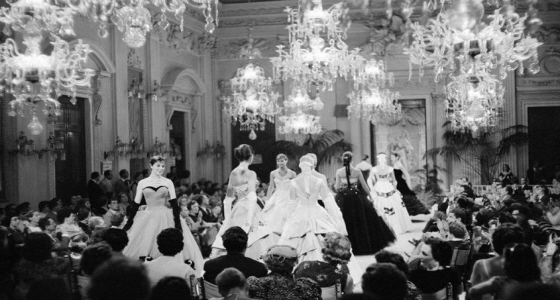
The exhibition concludes with a ‘Film Documentary’ room with contributions from key members of the fashion-industry, discussing the strengths and uniqueness of Italian fashion, and predicting what the future holds. A Gucci artisan says; “ ‘Made in Italy’, means ‘at the top’, as we use premium materials and craftsmanship – our clothing is made by people, not by technology”.
Angela Missoni agrees; “The uniqueness of Italian fashion lies in its use of artisanal production which goes back hundreds of years. Fashion is a good business export for Italy”. Franca Sozzani, Editor for Vogue Italia, concludes; “The connection via the internet is worldwide. Today, there is not a ‘client’ based on nationality or national boundaries. There are no boundaries for fashion and style”.
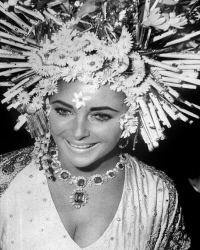 Further information on the “Glamour of Italian Fashion” exhibition is available at the V&A Website: www.vam.ac.uk. Tickets cost £12 (concessions available). The V&A is open daily from 10.00-17.45 and until 22.00 every Friday.
Further information on the “Glamour of Italian Fashion” exhibition is available at the V&A Website: www.vam.ac.uk. Tickets cost £12 (concessions available). The V&A is open daily from 10.00-17.45 and until 22.00 every Friday.





